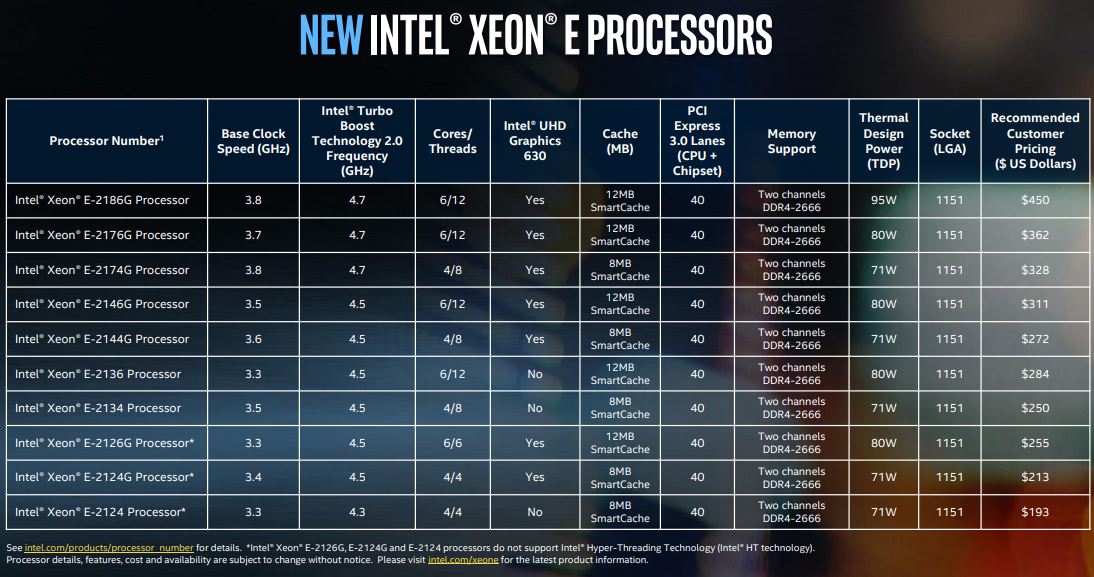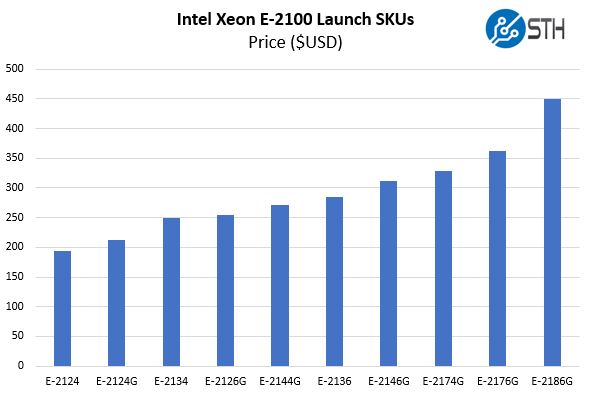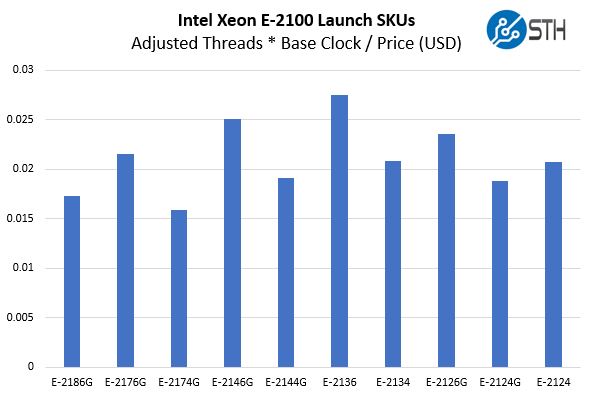Every 15 months or so we are accustomed to a new entry-level server CPU launch from Intel. With the Intel Xeon E-2100 series Intel is changing the naming convention for the first time since the Lynnfield to Sandy Bridge transition in 2011 when the X3400 series was succeeded by the Xeon E3-1200 series. The new series also shows a major shift in focus which weighs heavily on the SKU stack. In this article, we are going to discuss the Intel Xeon E-2100 SKUs based on Coffee Lake and do our normal SKU listing and value analysis. For those that remember our extensive Intel Xeon E3-1200 V6 Series Value Comparison, we are not going to use the same format since Intel has changed its market positioning with the line.
Intel Xeon E-2100 Launch SKUs
First off, here is the slide that Intel provided on the new CPUs. There are ten new SKUs with 70% of them including integrated GPUs. The major highlight features with this generation are the four 6 core/ 12 thread SKUs and the 6 core/ 6 thread Intel Xeon E-2126G CPU. This is the first time in this segment that Intel offers six-core chips. These cores are Coffee Lake cores, similar to the current “Intel Core” series of consumer parts.

We discussed the overall platform quite a bit in our Intel Xeon E-2100 An Updated Platform and Market Segment piece. The 40 lanes of PCIe are actually only 16x PCIe Gen3 lanes from the CPU and up to 24 from the chipset. The “G” series of CPUs have integrated graphics. In that article, we also discuss the market positioning as a product for corporate workstations which aligns with iGPU usage.
Longtime readers may be floored by this SKU stack for the simple purpose that the $450 price tag on the top-bin Intel Xeon E-2186G is the same as the previous generation Intel Xeon E3-1285 V6. That means Intel added 50% more cores at the same price point with this generation. We wanted to dissect this line as we have with other newly launched SKUs in our customary value analysis.
Intel Xeon E-2100 Value Analysis
In terms of raw dollar amounts, this is one of the flatter curves we have seen in recent memory. It was not long ago that top bin Intel Xeon E3-1200 SKUs sold for over $600.

Here is that same SKU stack above with a bit of math added. Intel CPUs in this segment tend to scale fairly linearly in terms of cores * clock speeds so we are using that as a proxy for relative performance. One will see that we are using base clocks here not turbo clocks.

We also started using the Adjusted Threads * Base Clock / Price formula to help distinguish between Hyper-Threading and not HT capable parts. We are using a 30% performance uplift for a HT thread versus a standard core. That is not true in all scenarios, but for desktop workloads, HT is generally a performance benefit.

As you can see the Intel Xeon E-2136, without the GPU is the leader when it comes to price and frequencies. This is a bit of a misnomer as the incremental cost to add a PCIe GPU, both in nominal and TCO terms will be greater than the incremental $27 to upgrade to the E-2146G. Integrated graphics are fine for the Microsoft Office and web browser applications that these chips are designed to run. As a result, we would call the Intel Xeon E-2146G the value leader in this segment.
Final Words
At the end of the day, these chips are designed for corporate workstations sold by large OEMs. They are designed to generally use iGPU graphics for low GPU demand applications. The majority of office workers do very little multi-video feed transcoding. In this generation, the Intel Xeon E-2146 is the value leader overall. We will give the nod to the Intel Xeon E-2136 if you are planning to add a PCIe GPU. The other extremely interesting chip int he Intel Xeon E-2126G. This CPU has an integrated GPU and has six cores. That will likely give a performance benefit versus the 4 core/ 8 thread Intel Xeon E-2144G in many applications and it is $17 less expensive.
In the market for low-cost corporate desktops, small dollar BOM cost savings add up to IT procurement organizations buying thousands of units from OEMs like HP, Dell, and Lenovo.




“They are designed to generally use iGPU graphics for low GPU demand applications. The majority of office workers do very little multi-video feed transcoding. ”
The majority of office workers will be happy with the latest Pentium processors + SSD + good amount of RAM, they do not need a Xeon workstation.
Someone that *needs* a Xeon workstation (vs a cheaper 4-8 core Intel Core or Ryzen) will likely need a dGPU.
Intel’s quicksync hw encode/decode that comes along with the iGPUs can be invaluable if you are using software that leverages it. I will pay extra for the iGPU every time.
“Intel Xeon E-2146 is the value leader overall.” I guess it should be E-2136 ?